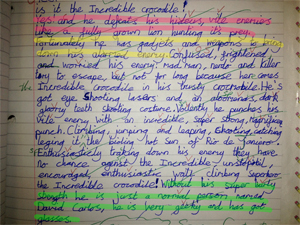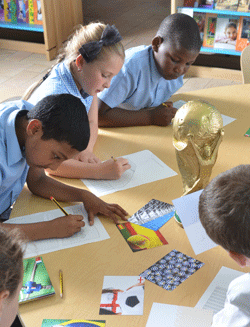The Premier League has launched a poetry competition for children aged five to 11. Backed by names from the worlds of football and literature, Premier League Writing Stars open to all Primary schools in England and Wales, and aims to get young people writing poetry in different creative forms.
Looking for a way to boost writing progress amongst your pupils this year? Searching for that elusive hook to inspire reluctant writers, or a way to showcase pupils’ work to a global audience? Step forward LitFilmFest - the Primary school festival, sponsored by YouTube Kids, that offers Key Stage 2 teachers free, fully-planned and resourced literacy units on a whole range of writing genres.
Pobble, the prize-winning global literacy initiative, has recently launched a new tool to facilitate lesson planning. Pobble Resources allows teachers to search content providers on Pobble and find the best teaching resources. They can then prepare the most engaging lessons easily, and share their lesson ideas, making collaborative planning really easy.
While today’s young people (Millennials and Generation Z) are very much just like the ones that preceded them - rebellious, searching for meaning, keen to understand the world and their place in it - they are at the same time completely different than any generation before them. The near limitless ability to consume information, organise with others, and communicate one’s thoughts makes this group very particular, to say the least.
One great part of receiving an education is exploring the world of fiction. James Harlan gives his five best examples for inspiring pupils to put pen to paper (or fingertips to keys…).

“An avenue for learning” – this is the primary offer of most schools. Yet, without bringing it to the fore, catalysing talents is actually another part of the package. The school environment has the immense potential to impact the development of its pupils’ talents, particularly, their gift at writing. The same analogy applies to us teachers.
While the beautiful San Diegan weather likely helps, it seems that the key to Kriscia Cabral’s cheerful outlook is fun, innovative teaching practices that really help her students. And what schoolchild doesn’t want to write on their desk?

Writeable furniture: the concept sounds silly. I agree. Of course, for those who are reading this, we are adults. We have forgotten about the little things in life. We have forgotten about how excited we used to get when we would bang the chalkboard erasers together. I remember being so amazed at my teacher when she used a crazy gadget that created five straight lines in a row with her chalk pieces, all at one time!
About four years ago I started the journey down the path of combination classes. Teaching two grades at one time has inspired me forever, but there was one big lesson I got out of it all.

The idea behind children blogging is simple: give them a platform to write for a real audience as this provides a purpose to write. When children have a purpose, it impacts on the quality of writing.
The most difficult part for teachers trying to encourage children to blog is to create an audience for children to write for. There are a few websites teachers can sign up to that will really help build an online audience. These are:
Photo credit: lupuca

For the past 5/6 years, my school has been using Big Writing in literacy to provide a focused time for children to write. As time has passed we have moulded our approach to include other useful aspects of literacy. We now tend to use our Big Writing session as a final piece to a particular text type focus, unless it is an assessed piece and has to be a standalone lesson. Often we use a Big Writing lesson at the start of a text type to assess what the children already know or can remember from previous years. This is a great way of informing future planning. For example, if you were covering 'Instructions' and few children used imperative verbs, this would inform you to focus on this in your planning.
After a year or so of using Big Writing, I started to think about the whole writing process. It was advised that during the next Big Writing session children should be given time to read back on their work, look at the comments and, as a class, decide on some “goal scorers.” This is a good way of revising, but I felt it wasn't enough; also, if it was a whole week or two later, the activity is long forgotten by the children. I am sure if you ask any author they will always say that the revising and editing part of writing is possibly the most important. But how can we teach this and instil a reflective approach in children? Timed writing sessions don’t provide this quality time to reflect on your writing. It led me to make a resource which I have found invaluable ever since.
This delightful animated video, created by students at the French university for careers in design, Bellecour Écoles D’Art, is absolutely enchanting. Monsterbox is only about 7 1/2 minutes long, and tells the story of a young girl who is trying to find a home for her monster – and then another monster, and then another! There is no dialogue, but the graphics and characters tell the story perfectly.
Here are some of the ways that it could be used in the classroom:

It's well known that many school children fear the ‘blank sheet of paper’ when asked to write about a particular topic. How to start, what tone to use, who is the audience, what purpose does this writing serve. The result is trepidation about writing, particularly by reluctant writers and often by boys.
How do we help children to feel more positively about writing and how can we provide interesting and inspiring stimulus for writing? One effective way is to create an authentic ‘event’ which the whole school is involved in. Perhaps an alien has landed in the school grounds, or the World Cup has been found hidden behind a tree in the playing fields. Use a few props to make the find look authentic and involve the whole school by asking all pupils to spend the day investigating the discovery and writing about it. Asking the children to write newspaper articles is a good way of providing an instant audience for their writing and having made the discovery in school makes the piece of writing incredibly relevant.

A community-driven platform for showcasing the latest innovations and voices in schools
Pioneer House
North Road
Ellesmere Port
CH65 1AD
United Kingdom